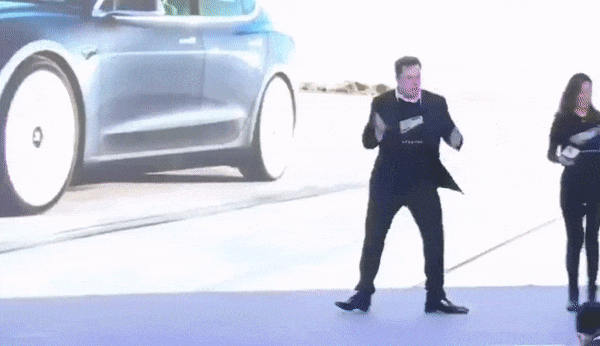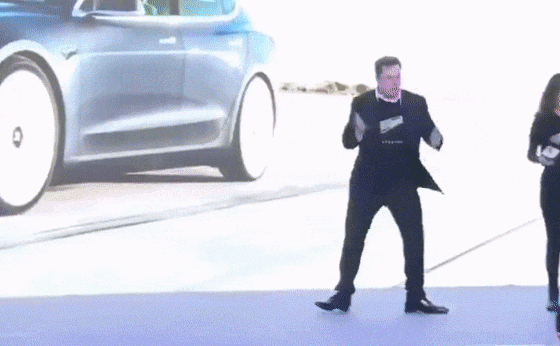

News
Elon Musk was right about Tesla in China, and March registrations prove it
Elon Musk believes China will be Tesla’s biggest advantage in the long term, and new data from a Chinese automotive organization that tracks vehicle registrations proves the CEO is right.
New data released by the China Automotive Information Net (CAIN) shows that registrations for Tesla surged to 34,635 in March, a new single-month record that virtually propelled the electric automaker into one of the most surprising quarters in company history. The 34,635 cars that Tesla successfully registered to Chinese customers was a near doubling compared to the 18,155 February registrations the automaker recorded just one month prior. Bloomberg also reported that the March 2021 numbers had nearly tripled compared to March 2020 figures when sales were disrupted by the COVID-19 pandemic that halted production at Tesla’s Giga Shanghai production plant for several weeks. The EV Sales Blog shows around 11,280 units sold in China in March 2020.
The record 34,635 cars that were registered in China contributed greatly to Tesla’s overall Q1 delivery and production numbers. Tesla announced on April 2nd that it had produced 180,338 cars and delivered 184,800 of them. This was a strong showing based on Wall Street estimates that pegged the automaker would deliver around 162,000 cars in Q1 2021. This was obviously a low estimate as Tesla managed to outperform the relatively bearish estimates by a considerable margin.
In the big picture, the delivery figures indicate CEO Elon Musk’s predictions regarding China are correct. In a recent interview, Musk claimed that the Chinese market would be one of the most important areas of focus that could contribute to Tesla’s growth. On a global scale, China has already proven to give Tesla plenty of demand while only manufacturing two of the company’s four vehicles in Shanghai. Still, the March figures show that China is more than ready to assist in the automaker’s global surge for dominance in a quickly growing Chinese automotive sector.
“China in the long term will be our biggest market, both where we make the most number of vehicles and where we have the most number of customers,” Musk said. “I’d like to strike an optimistic note, and I’m very confident that the future of China is going to be great and that China is headed towards being the biggest economy in the world and a lot of prosperity in the future.”
Musk’s predictions about China were expected. The automaker’s presence in the country has been electrifying since Tesla started delivering cars to owners in early 2020. Since then, growth has been the word to describe the company’s performance, and the Model 3 and Model Y have been the driving factors. The two vehicles have catered to the typical Chinese car buyer because of their affordability, and the several variants that both models offer match any driving style. The Model 3 has stood the test of time, managing to maintain a Top 3 position in Chinese sales charts since its introduction to the market in January 2020. The only car to dethrone the Model 3 from the top position is the Wuling HongGuang Mini EV, a $4,500 car with a low range and unfavorable performance ratings.
The Tesla Model Y is leading China’s electric SUV segment by a wide margin
Musk is right, and the numbers prove it. China will undoubtedly drive Tesla into the stratosphere by continuing to contribute to the company’s substantial growth. Although the pandemic slowed 2020’s figures, 2021 is proving to be one of Tesla’s most productive and momentous years to date. The financial figures for Q1 will be revealed during the Q1 2021 Earnings Call that Tesla will hold on April 26th.

News
Tesla China delivery centers look packed as 2025 comes to a close
Needless to say, it appears that Tesla China seems intent on ending 2025 on a strong note.

Tesla’s delivery centers in China seem to be absolutely packed as the final days of 2025 wind down, with photos on social media showing delivery locations being filled wall-to-wall with vehicles waiting for their new owners.
Needless to say, it appears that Tesla China seems intent on ending 2025 on a strong note.
Full delivery center hints at year-end demand surge
A recent image from a Chinese delivery center posted by industry watcher @Tslachan on X revealed rows upon rows of freshly prepared Model Y and Model 3 units, some of which were adorned with red bows and teddy bears. Some customers also seem to be looking over their vehicles with Tesla delivery staff.
The images hint at a strong year-end push to clear inventory and deliver as many vehicles as possible. Interestingly enough, several Model Y L vehicles could be seen in the photos, hinting at the demand for the extended wheelbase-six seat variant of the best-selling all-electric crossover.
Strong demand in China
Consumer demand for the Model Y and Model 3 in China seems to be quite notable. This could be inferred from the estimated delivery dates for the Model 3 and Model Y, which have been extended to February 2026 for several variants. Apart from this, the Model Y and Model 3 also continue to rank well in China’s premium EV segment.
From January to November alone, the Model Y took China’s number one spot in the RMB 200,000-RMB 300,000 segment for electric vehicles, selling 359,463 units. The Model 3 sedan took third place, selling 172,392. This is quite impressive considering that both the Model Y and Model 3 are still priced at a premium compared to some of their rivals, such as the Xiaomi SU7 and YU7.
With delivery centers in December being quite busy, it does seem like Tesla China will end the year on a strong note once more.
News
Tesla Giga Berlin draws “red line” over IG Metall union’s 35-hour week demands
Factory manager André Thierig has drawn a “red line” against reducing Giga Berlin’s workweek to 35 hours, while highlighting that Tesla has actually increased its workers’ salaries more substantially than other carmakers in the country.

Tesla Giga Berlin has found itself in a new labor dispute in Germany, where union IG Metall is pushing for adoption of a collective agreement to boost wages and implement changes, such as a 35-hour workweek.
In a comment, Giga Berlin manager André Thierig drew a “red line” against reducing Giga Berlin’s workweek to 35 hours, while highlighting that Tesla has actually increased its workers’ salaries more substantially than other carmakers in the country.
Tesla factory manager’s “red line”
Tesla Germany is expected to hold a works council election in 2026, which André Thierig considers very important. As per the Giga Berlin plant manager, Giga Berlin’s plant expansion plans might be put on hold if the election favors the union. He also spoke against some of the changes that IG Metall is seeking to implement in the factory, like a 35-hour week, as noted in an rbb24 report.
“The discussion about a 35-hour week is a red line for me. We will not cross it,” Theirig said.
“(The election) will determine whether we can continue our successful path in the future in an independent, flexible, and unbureaucratic manner. Personally, I cannot imagine that the decision-makers in the USA will continue to push ahead with the factory expansion if the election results favor IG Metall.”
Giga Berlin’s wage increase
IG Metall district manager Jan Otto told the German news agency DPA that without a collective agreement, Tesla’s wages remain significantly below levels at other German car factories. He noted the company excuses this by referencing its lowest pay grade, but added: “The two lowest pay grades are not even used in car factories.”
In response, Tesla noted that it has raised the wages of Gigafactory Berlin’s workers more than their German competitors. Thierig noted that with a collective agreement, Giga Berlin’s workers would have seen a 2% wage increase this year. But thanks to Tesla not being unionized, Gigafactory Berlin workers were able to receive a 4% increase, as noted in a CarUp report.
“There was a wage increase of 2% this year in the current collective agreement. Because we are in a different economic situation than the industry as a whole, we were able to double the wages – by 4%. Since production started, this corresponds to a wage increase of more than 25% in less than four years,” Thierig stated.
News
Tesla is seeing a lot of momentum from young Koreans in their 20s-30s: report
From January to November, young buyers purchased over 21,000 Teslas, putting it far ahead of fellow imported rivals like BMW and Mercedes-Benz.

Tesla has captured the hearts of South Korea’s 20s-30s demographic, emerging as the group’s top-selling imported car brand in 2025. From January to November, young buyers purchased over 21,000 Teslas, putting it far ahead of fellow imported rivals like BMW and Mercedes-Benz.
Industry experts cited by The Economist attributed this “Tesla frenzy” to fandom culture, where buyers prioritize the brand over traditional car attributes, similar to snapping up the latest iPhone.
Model Y dominates among young buyers
Data from the Korea Imported Automobile Association showed that Tesla sold 21,757 vehicles to the 20s-30s demographic through November, compared to BMW’s 13,666 and Mercedes-Benz’s 6,983. The Model Y led the list overwhelmingly, with variants like the standard and Long Range models topping purchases for both young men and women.
Young men bought around 16,000 Teslas, mostly Model Y (over 15,000 units), followed by Model 3. Young women followed a similar pattern, favoring Model Y (3,888 units) and Model 3 (1,083 units). The Cybertruck saw minimal sales in this group.
The Model Y’s appeal lies in its family-friendly SUV design, 400-500 km range, quick acceleration, and spacious cargo, which is ideal for commuting and leisure. The Model 3, on the other hand, serves as an accessible entry point with lower pricing, which is valuable considering the country’s EV subsidies.
The Tesla boom
Experts described Tesla’s popularity as “fandom culture,” where young buyers embrace the brand despite criticisms from skeptics. Professor Lee Ho-geun called Tesla a “typical early adopter brand,” comparing purchases to iPhones.
Professor Kim Pil-soo noted that young people view Tesla more as a gadget than a car, and they are likely drawn by marketing, subsidies, and perceived value. They also tend to overlook news of numerous recalls, which are mostly over-the-air software updates, and controversies tied to the company.
Tesla’s position as Korea’s top import for 2025 seems secured. As noted by the publication, Tesla’s December sales figures have not been reported yet, but market analysts have suggested that Tesla has all but secured the top spot among the country’s imported cars this year.








